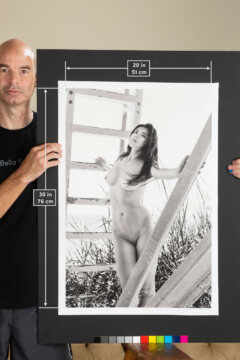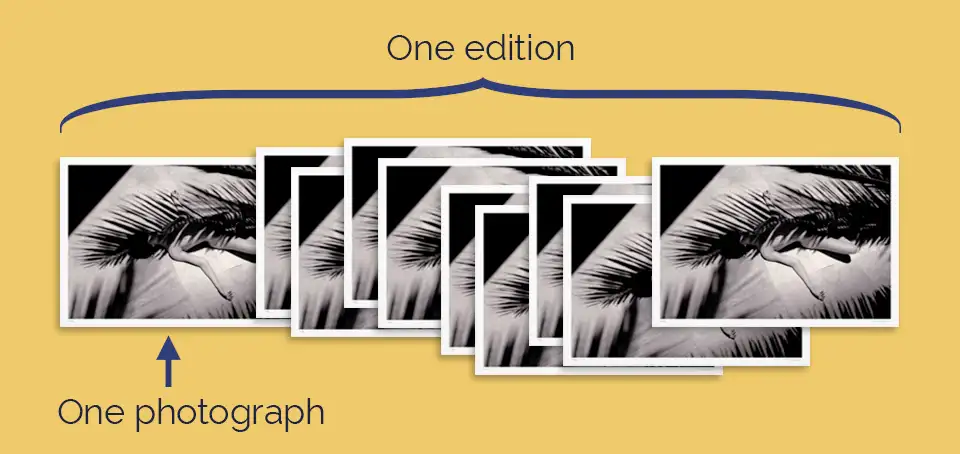What is a Limited Edition?
Here's what to know before you buy a limited edition photograph. A limited edition is made of multiple copies and constrained to a pre-defined quantity. The collective term for the entire group of photographs made of a specific image is an "edition."
For example, if ten photographs are produced of a single image, that is one edition of ten photographs.
Collecting limited edition photographs is a rewarding pursuit for many art lovers. This article contains perhaps more than you want to know about collecting limited editions, and photographs in particular. Most is general information, but specifics related to artist Aaron Knight are included to answer frequently asked questions.
Contents
What to know when you buy a limited edition photograph
Each photograph in the edition is an object of art with an individual number, followed by a slash, then the edition quantity. For example, in an edition of 10 photographs, the first would be 1/10, the second 2/10, and the last is 10/10.
This unique number is handwritten in the bottom margin, usually in the left corner. The artist's signature attests that the photograph has been personally inspected and approved.
"Limited" means the quantity of photographs is finite and pre-defined. No photographs will be added beyond the number stated for the edition and when this edition sells out, no new editions will be made of the same image.
Limited editions are produced in very small numbers. What constitutes "very small numbers" is subjective, however. For most collectors, there is a distinction for limited editions of 150 or fewer. (Although some may draw the line at editions larger than 100 or 200.)
Taking a cue from history, it was often impossible to produce editions in unlimited quantities due to the limitations of hand etched plates or lithographic stones. Some serious collectors prize editions with 50 or fewer photographs.
In short, a limited edition is:
- Produced in small quantity
- Not a copy of another artwork
Talking about limited editions
- To talk about the numbering on a photograph, say "one of ten, two of ten, ten of ten, and so on."
- To talk about what you have, say "This is a photograph from a limited edition."
- Note that to say "
I just bought an edition" means refers to every photograph (e.g. 10 of the same image) in the edition. - Remember that "edition" is a collective noun, like "team, class, family." And photograph is a singular noun, like "player, student, individual".
Why do photographers make limited editions?
When you buy a limited edition photograph, two fundamental options exist: open editions, and limited editions. In an open edition, the artist (or often a print shop) freely prints as many multiples in whatever size she or he desires. Open editions do not need to be planned in advance.
A limited edition, on the other hand, is planned in advance. The dimensions of the image and the quantity made is known beforehand. This knowledge gives collectors peace of mind when they buy a limited edition photograph.
Limited editions have a long history that predates photography. Lithographs, screen prints, woodcuts, and engravings are just a few examples of limited edition media. Artists such as Sandy Skoglund, David Hockney, Olivia De Berardinis, Pablo Picasso, Andy Warhol produced limited editions in a variety of non-photographic media. In many cases, an artist would collaborate with a skilled printmaking technician to ensure consistent, high-quality results. In this way, photography is connected to the tradition of producing limited editions.
Photographers such as Edward Weston and Helmut Newton produced signed and numbered limited edition photographs that owe much of their value to their limited nature. When you buy a limited limited edition photograph and comparing these to posthumously produced images, the distinction is clear. Those signed and numbered by the artist are more prized.
Reducing confusion around limited editions
There are some gray areas that have muddied the prestige of limited editions and confused some who might otherwise buy a limited edition photograph. These include:
- Editions so large they are de facto limited only by the number that can be sold.
- Artists who produce both limited and open editions of the same image.
- Artist who produce additional sizes without disclosing this up front. It's fine to have multiple sizes in an edition, but simply issuing more sizes to increase the quantity available means the edition is not really limited.
- Artists who do not disclose the quantity of the edition up front or otherwise obscure how rare (or not rare) each photograph is.
- Limited editions that are a reproduction of an original artwork, for example, a copy of a painting.
- Licensed images that are numbered but unsigned or signed by someone other than the artist, often sold by a third party with a certificate that is signed by someone other than the artist.
When you buy a limited edition photograph from Aaron Knight, rest assured that he does not engage in any of the confusing practices listed above. Read more about buying artist direct.
Original, unique, or reproduction?
Original, unique, and reproduction are all words that are the source of frequent questions. Although not unique, each photograph in a limited edition is an original artwork. The exceptions to this are photographs of artworks produced in another media, such as a reproduction of a painting. Lithography, sculpture, screen printing, and photography all fall into a category of art where originals are produced as multiples. Although there may be a printing plate, film negative, digital file, or sculpture mold that corresponds to the finished artwork, these items (each called a matrix) are not finished artworks, but rather parts of each process. One way to remember what is an original artwork is to ask if there is another version, created earlier, in a different medium (such as the example of the photographic copy of an oil painting.)
Who buys limited edition photographs?
Those collecting limited edition photographs by Aaron Knight includes people in places and professions that you might expect and some that you might not have guessed. It may not surprise you that lawyers, physicians, a Hollywood filmmaker, or a corporate CEO are among collectors of Knight’s work. However, there are also law enforcement officers, other photographers, data-entry clerks, and software coders amongst them. Creative types like other artists and a Hollywood film director round out the list. They reside in over a dozen countries, from Australia to the United States, but also places like Japan and Jordan. The accessibility of art does not diminish its appeal for those who truly appreciate art for what it is rather than what it costs.
How to start collecting limited edition photographs?
The first time you buy a limited edition photograph, ask yourself the following:
- Is this artwork something I want to keep long term? If I don't buy it will I regret it?
- Is the artwork signed by the artist? Check out this article on artists signatures.
- Is the artwork numbered and limited to fewer than 150 photographs.
- Is there a certificate of authenticity? Read this article on certificates of authenticity.
Also see this advice for new art collectors.
Common Questions
Can't you make as many multiples as you want? No. The tirage (all multiples of a work made) including any artist's proofs, printer's proofs, hors d’commerce proofs are established before an artwork is offered for sale. On each artwork's for-sale listing, collectors will find clear information of how many photographs are in the edition.
What are proofs, such as an artist's proof? An artist proof is an additional photograph, intended for the artist's use, such as his own collection or a gift to the model or other party involved in making the artwork. Hors d’commerce (not for sale) proofs are sometimes traded for services, for example someone who's property appears in the photograph. The number proofs are minimal, typically two or three per edition, and disclosed in the listing. Many limited editions do not include any proofs. Instead of being numbered, proofs are marked AP, HC, or PP.
Why don't you have small, medium, and large options for each image? Aaron Knight is traditional in his approach to limited editions. Each artwork is produced in one size, deliberately chosen to present that composition. This is a connection to traditions dating back for centuries. Serious and repeat collectors appreciate this meticulous philosophy, the distinction from decoration, and a refreshing break from ubiquitous merchandising.
Are the first photographs from an edition more valuable? Traditionally, no. Although some collectors take pride in being among the first, all photographs in an edition are equal in value. The numbering shown on product pages is for illustrative purposes, actual sequence number is on a first-order basis.
Are the photographs originals? Yes. Also, see the next answer.
What are the differences between originals, reproductions, and unique art? An original exists in the material/technique in which the artist first created it. Photography, screen printing, etching, and cast sculpture are examples of original artworks created in multiples. A reproduction is a copy of something else, for example, a reproduction of a painting. Unique (one of a kind) artworks are generally most prized, followed by originals in limited edition, then reproductions.

